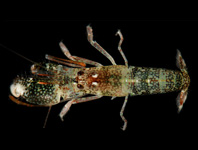Abstract
A new species of lysmatid shrimp, Lysmata leptodactylus n. sp., is described and illustrated based on specimens collected from the subtidal zone in Guangdong province, South China Sea. The new species bears distinctly unequal second pereiopods and uniquely elongated gracile dactyli of the ambulatory pereiopods. These characters, combined with the rostral formula, and stylocerite proportion, immediately distinguish Lysmata leptodactylus n. sp. from all known species of lysmatid shrimp.
References
Baeza, J.A. (2009) Protandric simultaneous hermaphroditism is a conserved trait in Lysmata (Caridea: Hippolytidae): implications for the evolution of hermaphroditism in the genus. Smithsonian Contributions to Marine Science, 38, 95–110.
Baeza, J.A. (2010) Molecular systematics of peppermint and cleaner shrimps: phylogeny and taxonomy of the genera Lysmata and Exhippolysmata (Crustacea: Caridea: Hippolytidae). Zoological Journal of the Linnean Society, 160, 254–265.
http://dx.doi.org/10.1111/j.1096-3642.2009.00605.xBaeza, J.A., Bolanos, J.A., Hernandez, J.E. & Lopez, R. (2009). A new species of Lysmata (Crustacea, Decapoda, Hippolytidae) from Venezuela. Zootaxa, 2240, 60–68.
Bauer, R.T. & Holt. G.J. (1998) Simultaneous hermaphroditism in the marine shrimp Lysmata wurdemanni (Caridea: Hippolytidae): an undescribed sexual system in the decapods Crustacea. Marine Biology, 132, 223–235.
http://dx.doi.org/10.1007/s002270050388Bracken, H.D., de Grave, S. & Felder, D.L. (2009) Phylogeny of the Infraorder Caridea based on mitochondrial and nuclear genes (Crustacea: Decapoda). In: Martin, J.W., Crandall, K.A. & Felder, D.L. (Eds.), Decapod Crustacean Phylogenetics. CRC Press, Taylor & Francis Group, Boca Raton, FL, pp. 281–305.
Bruce, A.J. (1986) Redescriptions of five Hong Kong carideans first described by William Stimpson, 1860. Proceedings of the second international marine biological workshop: The marine fauna and flora of Hong Kong and southern China, Hong Kong, 1986, 569–610.
Chace, F.A., Jr. (1997) The caridean shrimps (Crustacea: Decapoda) of the Albatross Philippine Expedition, 1907–1910, Part 7: Families Atyidae, Eugonatonotidae, Rhynchocinetidae, Bathypalaemonellidae, Processidae, and Hippolytidae. Smithsonian Contributions to Zoology, 587, 1–106.
Christoffersen, M.L. (1987) Phylogenetic relationships of hippolytid genera, with an assignment of new families for the Crangonoidea and Alpheoidea (Crustacea, Decapoda, Caridea). Cladistics, 3, 348–362.
http://dx.doi.org/10.1111/j.1096-0031.1987.tb00898.xChristoffersen, M.L. (1990) A new superfamily classification of the Caridea (Crustacea, Pleocyemata) based on phylogenetic pattern. Journal of Zoological Systematics and Evolutionary Research, 28, 94–106.
http://dx.doi.org/10.1111/j.1439-0469.1990.tb00369.xDe Grave, S. & Fransen, C.H.J.M. (2011) Carideorum catalogus: the recent species of the Dendrobranchiate, Stenopodidean, Procarididean and Caridean Shrimps (Crustacea: Decapoda). Zoologische Mededelingen, 85, 195–589.
De Grave, S., Li C.P., Tsang, L.M., Chu, K.H. & Chan, T-Y. (2014) Unweaving hippolytoid systematics (Crustacea, Decapoda, Hippolytidae): resurrection of several families. Zoologica Scripta, 43, 496–507.
http://dx.doi.org/10.1111/zsc.12067Fiedler, G.C. (1998) Functional, simultaneous hermaphroditism in femalephase Lysmata amboinensis (Decapoda:Caridea: Hippolytidae). Pacific Science, 52, 161–169.
Fransen, C. (1991) Lysmata olavoi, a new shrimp of the family Hippolytidae (Decapoda, Caridea) from the eastern Atlantic Ocean. Arquipélago, Life and Earth Sciences, 9, 63–73.
Hayashi, K.I. (1975) Hippolysmata grabhami Gordon, a synonym of Lysmata amboinensis (De Man) (Decapoda, Caridea, Hippolytidae). Publications of the Seto Marine Biological Laboratory, 22, 285–296.
Hayashi, K.I. (2007) Lysmata dispar sp. nov., a new shrimp from the Dampier Archipelago, Western Australia, with notes on other species of the family Hippolytidae (Crustacea: Decapoda: Caridea). Records of the Western Australian Museum Supplement, 73, 85–95.
Kemp, S. (1914) Notes on Crustacea Decapoda in the Indian Museum. V. Hippolytidae. Records of the Indian Museum, 10, 81–129.
http://dx.doi.org/10.5962/bhl.part.5624Liu, J.Y. (2008) Checklist of marine biota of China seas. Science Press, Beijing, 1627 pp.
Okuno, J. & Fiedler, G.C. (2010) Lysmata lipkei, a new species of peppermint shrimp (Decapoda, Hippolytidae) from warm temperate and subtropical waters of Japan. Crustaceana Monograph, 2010, 597–610.
Onaga, H., Fiedler, G.C. & Baeza, J.A. (2012) Protandric simultaneous hermaphroditism in Parhippolyte misticia (Clark, 1989) (Caridea: Hippolytidae): implications for the evolution of mixed sexual systems in shrimp. Journal of Crustacean Biology, 32, 383–394.
http://dx.doi.org/10.1163/193724012X626520Rhyne, A.L., Calado, R. & dos Santos, A. (2012) Lysmata jundalini, a new peppermint shrimp (Decapoda, Caridea, Hippolytidae) from the Western Atlantic. Zootaxa, 3579, 71–79.
Soledade, G.O., Baeza, J.A., Boehs, G., Simoes, S.M., Santos, P.S., da Costa, R.C. & Almeida, A.O. (2013) A precautionary tale when describing species in a world of invaders: morphology, coloration and genetics demonstrate that Lysmata rauli is not a new species endemic to Brazil but a junior synonym of the Indo-Pacific L. vittata. Journal of Crustacean Biology, 33, 66–77.
http://dx.doi.org/10.1163/1937240X-00002122Xu, P. & Li, X.Z. (2015) Report on the Hippolytidae Bate (sensu lato) from China seas. Zoological Systematics, 40, 107–165.

